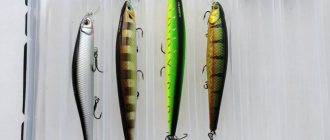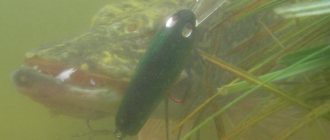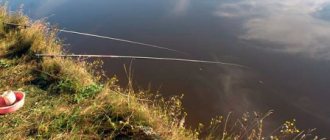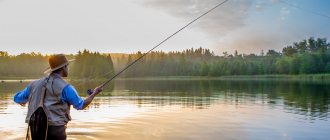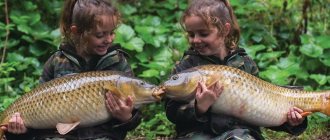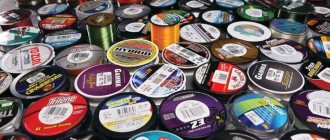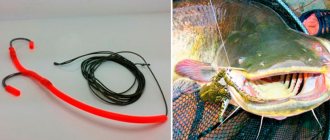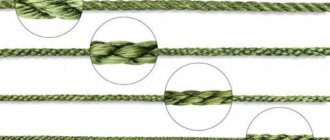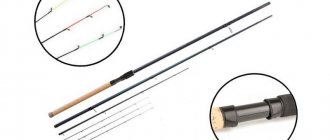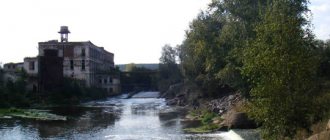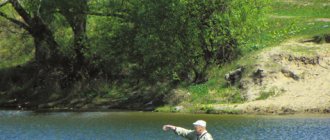Fishing places and their signs
First and most important, the fisherman should inspect the pond and monitor the activity of fish by circles in the water, air bubbles or moving reeds. To observe the water, it is best to choose the highest point on the shore. If possible, you can even climb a tree. This makes it possible to observe a large area and, under good conditions, see the silhouettes of fish under the surface of the water.
Particularly noteworthy are the thickets of reeds, water lilies and trees growing on the shore, as well as driftwood already lying in the water. It is in these places that fish often feed. Watching the water may seem unnecessary, but it is not, because the more time a person spends identifying habitats or feeding prey, the larger the catch he will get.
Reeds
This is a place that is especially loved and often visited by carps and other inhabitants of the reservoir. They are rich in a lot of natural food lying at the bottom. The underwater part of the shoots is covered with numerous accumulations of snails and other fish delicacies.
The so-called windows (voids among lake thickets) will be good places to throw gear. The best results are achieved when the hook is thrown to a point located at a distance of 0.5–1.5 m from the edge of the reeds.
Water lilies
Water lilies are another wonderful place that every angler will appreciate. As in the case of reeds, this is a dining room for carp fish and crucian carp. They abound in snails, bloodworms and other aquatic mollusks. During the feeding hours of the fish, you can observe the leaves of water lilies moving, as if on their own. This greenery gives the carp shade on hot days. As with reed thickets, it is best to place gear at a distance of 0.5 m to 1.5 m from water lily thickets.
Coastal trees
Fish are also found under trees growing near the water. However, this is a catchable place more likely for the warm season, when the trees bloom or bear fruit, and there are also a lot of all kinds of insects on them. Here the fish also find shelter and shade on hot days. This is a kind of dining room where fish breeds can choose from a varied menu.
It should be remembered that the bottom in such a place is strewn with branches on which snails often settle, and there is also a large layer of fallen leaves. Here the hooks are thrown as close to the plants as possible, or even right under the hanging branches. It is quite difficult to work with such water areas, since each bite can result in the fishing line getting tangled in the branches and the loss of prey. Therefore, it is important to take it out into open water as soon as possible after the fish takes the bait.
Islands
The area around the islands is also an excellent place to place gear. Especially areas that are located at a considerable distance from the coast, where it is difficult to reach without a boat. For fish there is a lot of food in the form of water striders, snails, various larvae, as well as peace and quiet around. The shape of the bottom often encourages carp to come to such places. Typically, fishing rods are installed on coastal slopes.
Underwater windbreaks
The most difficult place is the bottom with hard snags left over from fallen trees, old stumps and roots. Fish in such places feel safe and become less suspicious and timid. However, the fisherman here needs to be vigilant and constantly be on guard. You need to keep your eyes on the float while waiting for a bite. When fishing near sunken trees, a different bait strategy must be prepared and gear must be durable and abrasion resistant. This is especially true for fishing line. Such areas are very difficult, but if chosen correctly, they can provide an excellent catch.
All of the fishing spots mentioned have a few things in common that make up the main sign of a great fishing spot. The defining conditions are peace, quiet, abundance of natural food and a sense of security. When choosing where to go fishing, you should remember the above places.
How to choose a fishing spot on the river
Promising places for fishing on the river
On small rivers
On small rivers, catchable places can be found in pits; on narrow rivers - places where the channel widens, as well as bays; on rivers with a slow flow - narrowing of the channel, places of rapids and channels, and on rivers with a fast flow - spills and bays; on deep rivers - the boundaries of depths and shallows, channels and “furrows” that separate the shallows from the shore, as well as at the border of algae. Fish can be found near blocks of soil that are washed into the water near cliffs.
Places where cattle gathered to drink in the evenings were always considered promising. At this moment, the fish stays closer to the border of the turbidity that the animals raise. Of particular interest are places littered with snags or driftwood. At the very top of the pool, where the current rushes in from the riffle, large specimens of fish, as well as predators, stay. A little further, where the current is not so strong, fish such as ide and chub like to spend time. The middle of the pool and its edges are occupied by other species of fish.
You should not pass by waterways where reverse currents predominate. They are usually located behind various obstacles that change the direction of movement of the bulk of the water. The smaller the distance between the forward and reverse currents, the more interesting the water is for fish.
Holes with thickets of trees and bushes that hang over the water can be a good place for fishing Shallows that rarely extend into the depths can also be effective.
Large fish bite best in river bays, where the water depth is sufficient for the fish to be at the bottom, but at the same time its temperature is acceptable and there is the necessary food. You can catch fish in such a place by casting a spinning rod or feeder at the optimal distance. The depth of the water can be determined by its color, without even using an echo sounder.
Fish Finding Tools
Having visually selected several places, you should begin sounding the bottom, which can be done in several ways. Using a fishing rod and marker, a pontoon, a fish finder and a rocker, or a remote controlled model with a fish finder. If the water is clear enough, a pontoon and rocking boat will suffice, saving a lot of time and effort.
All of these tools are designed to give fishermen an idea of what is below the pond, how deep it is, whether the bottom is hard or muddy, and whether there is any vegetation under the water column. This information will be useful when choosing a place to install gear.
How to choose a fishing spot on a lake or reservoir
Fish everywhere, in any body of water, choose characteristic places, which are sometimes hidden under the water column. This is especially true for lakes and reservoirs, but even here, if you look carefully, you can easily find the favorite places of fish. In reservoirs with dense vegetation, fish may be in “clearings” or in windows of clear water. She doesn’t mind stopping at islands that have minor algae thickets. As for reservoirs, fish constantly migrate in them through holes, ravines, along edges and slopes, especially if there is a current in such places.
Determination of bottom relief
If you are very careful, the bottom topography can be determined by the pattern of the river bed and the presence of this or that vegetation. Plants such as hornwort, urutu or villain can grow at depths of more than 4 meters. At depths of up to 3 meters water lilies grow, a little deeper - egg capsules, at depths of up to 2 meters okuga and reeds grow, and a plant such as horsetail has chosen depths of up to 1.5 meters. Coastal plants such as cattail and sedge grow at depths of up to 1 meter. At depths of up to 6 meters, algae called “water moss” grow, invisible to fishermen.
Floating plants such as duckweed and bladderwort can be found on bodies of water and can indicate the direction of prevailing winds.
A suitable place for autumn fishing
When the angle of incidence of the sun's rays changes, the wind begins to tear the hats off the heads of passers-by, and the rain knocks on the windows, there is no need to complain about the weather. It’s better to try to take advantage of the autumn bad weather and enjoy fishing.
Pisces also experience the effects of the autumn climate, especially in the morning, at night and in the evening, when the approach of winter is very noticeable. During this period, the inhabitants of any body of water are actively searching for food and constantly feed, insulating the carcass with fat. This means that you can count on a successful catch with a higher probability than in the summer. Many fish species multiply their activity in search of food in cold water, so you can fish all day long.
River, lake or sea - where and how best to fish in the fall
Those who love secluded fishing spots, peace and quiet can catch several large specimens of roach and bream in the lake using a float or fishing rod. In ponds, pike and perch are often caught with a fishing rod; this can be done both from a boat and from the shore. Bream, roach, chub and ide can be caught using a feeder or live bait.
In autumn, pike and pike perch are caught from the river bank. For this, fly fishing is recommended, thanks to which you can catch grayling in the coastal thickets. To hunt this fish, you should go deeper into the water and fish by wade or from the shore. At night, when the temperature drops, you can expect a large number of burbot. In a larger body of water, for example in the sea, autumn cod is successfully caught from a boat, and from the beach during the day or after dark they cast gear for bream and flounder.
The autumn season is also the time to catch carp, which can be caught either with a hook lying on the ground or with a float.
How to choose the right place for autumn fishing
A very important aspect of fishing in the fall is choosing the right place. Sometimes it will be a quiet seclusion of bays among yellowing reeds, and sometimes deeper pools where the bottom breaks off or there are waterfalls, underwater hills surrounded by wild vegetation. Fish will primarily look for areas where the water temperature is warmer and there is plenty of plant matter to eat. That is why it is worth paying attention to falling vegetation, where snails, water worms or insect larvae will live. If a fisherman wants to catch large specimens of bream, he must settle with his fishing rods closer to the current, because these fish collect food that the river flow brings. Bream is found on both muddy and rocky bottoms. In contrast, perch can be caught outside the area of the strongest current. It lives in shallow water, and in the river it swims near the bottom.
Carp and pike in autumn
Carp, for which autumn is the most active time, like to stay on windward shores, where the water is sufficiently oxygenated and warm. They also live in underwater thickets, which provide them with shelter and plentiful food while awaiting the winter. Compared to carp and bream, roach is found in smaller and calmer places, rivers and canals. This fish very often winters in old harbors and the mouths of small rivers, the current of which is slower.
In September, pike are found in shallow water, not far from the reeds. On the other hand, chubs live in deeper, calm water. Large specimens are often caught in stagnant and muddy waters. In autumn, Yazi usually choose places with calm currents. They can be found in creeks where the reverse movement of water is visible.
What to fish with in the fall
Of course, the use of baits and groundbaits in the fall should not be reduced. During this period, the water temperature drops, so the fish need more food and feed throughout the day. It is recommended to use the highest quality baits. You shouldn’t get carried away with a large amount of complementary foods; it’s more important to think about what exactly to throw into the river. When cold days arrive, it is worth limiting the use of grains and increasing the amount of pellets, boiled hemp and dough balls.
The bait should also be enriched with legumes, such as peas. It is also good to add corn, some bloodworms, as well as ordinary earthworms. In the fall, it is worth setting out the bait as best as possible, for example, by purchasing floats with neutral buoyancy. Their size is not predetermined, but depends on the natural fishing conditions and the specifics of the fish that live there. Sometimes floats with a diameter of 8-10 millimeters are effective, and sometimes thicker ones, up to 24 millimeters thick in the central part. The olfactory factor is also important. Some fishermen recommend crab and halibut imitation scents, while others report fruity scents like strawberry and peach that carry well in cold water.
Some tips on how to find the perfect place so as not to be left without a catch:
- An easy way is to conduct a survey. A little research can go a long way. If an inexperienced fisherman has time before fishing, it is advisable to look into local shops with fishing supplies and ask around. The smaller and older the fishing store, the better! There you can always gain specific information characteristic of a given area. Informants can be both employees of a retail outlet and customers.
- Getting to know other fishermen can also help in this matter; you should always listen to the advice of experienced comrades.
- If the previous suggestions do not apply, you can always look for information on the Internet. Information on specific rivers, reservoirs or lakes should be found on fishing forums, websites or other Internet resources where you can communicate with fishing enthusiasts. Anglers are often very careful about revealing their secrets, so it is worth asking for advice in a polite and respectful manner. At the same time, we must not forget that almost all fans of this type of hunting tend to tell stories about the “big fish.” Therefore, it is advisable to take it with humor if someone boasts of an excellent catch, but refuses to say where this amazing place is.
Angara
Irkutsk region
They go fishing on the Angara once - so that they can remember it for the rest of their lives. After all, the Angara is a legendary river where you can catch sorog, tugun, dace, omul and the king fish - sturgeon.
Favorite places for fishermen on the Angara are the Bratsk, Irkutsk and Ust-Ilimsk reservoirs. You can fish in narrower places of the river, but it is important to adapt to its steep temperament - the Angara is quite violent.
There are also bays downstream where you can catch pike. Grayling is also caught here throughout the year, some specimens of which reach 2 kg. But it’s better to go for taimen at the end of summer; hunting for this fish from a boat is especially good.
PROTOURISM wishes you neither tail nor scales!
Finding a place for ice fishing
The first and last ice are periods when even an inexperienced fisherman can count on a good result. At the beginning of winter, in reservoirs with stagnant or lazy water, ordinary fish swim in shallow water, eating up the remnants of summer feeding grounds. Dead underwater meadows, vast shallows, bottom elevations and gentle slopes are visited by more diverse peaceful fish. Predators move lazily near schools of fish - schools of perch, rare and motionless pike. Where the rocky or clay bottom begins, groups of small pike perch hide in slightly deeper waters.
There is still a lot of oxygen left in November water. Autumn winds cooled the surface, large temperature changes caused the exchange of water masses. The fish still have an appetite, and the abundance of oxygen significantly speeds up their metabolism. In shallow water it is a little warmer, the bottom still warms up during the day. It will take several weeks for it to cool down.
At the beginning of winter, shallows ranging from one to three meters abound with perch and roach, which aggressively attack the bait. Small areas of reservoirs are rarely visited by schools of larger fish; this happens only on warmer and brighter days.
The first ice is not too thick, so you can pick or drill many holes in it. Large roach, sometimes silver bream and bream, as well as thick perch, move at the beginning of winter along the edges of not very steep slopes adjacent to shallow water. They especially like the “stepped” shape of the bottom - a low underwater hill, a slope, another peak and again a creek. Which places are located close to fertile, abundant food shallows, and also provide a safe refuge. This is where you should look for good prey.
The specific depth range should also be taken into account. For example, in steep glacial lakes with a depth of 4-8, there are practically no fish, since there is a lack of oxygen and food. At the beginning of winter and early spring, in shallow water, schools often swim into any bottom fracture. Therefore, during this period it is recommended to throw fishing rods with bait there.
In deep ribbon lakes there are winter fish refuges even at a depth of 15-16 meters. They usually look like extensive bottom flattenings; it is from this plain that dozens of bream, silver bream, roach and perch are caught in winter. In shallow ponds and rivers, fish do not gather in such huge schools; they are more dispersed, occupying every hole and depression on the bottom. An angler who casts gear into the deepest part of a small body of water (for example, into a 10-meter hole in a lake with an average depth of 4 m) is usually disappointed. Such exceptional depths, even in winter, can be a place for the accumulation of hydrogen sulfide and remain almost completely without air.
Fish care not only about depth, but also about oxygen content and the availability of food. As a rule, wintering sites are chosen in the immediate vicinity of underwater hills or the coastal zone. During favorable periods, fish feed on a gentle slope.
Reservoirs
If we highlight the key differences between lakes and other bodies of water on Earth, they will be presented as follows:
- Water is able to maintain its chemical composition for many years, because sediment renewal occurs slowly.
- The impact on the regime and strength of existing currents is minimal.
- A variety of chemical reactions take place in lakes, which contribute to the transition of suspended matter from water to sediment at the bottom and vice versa.
- Lakes play an important role in creating the climate of the surrounding area.
- In such reservoirs there are thick layers of sediment at the bottom.
If your river is wide, choose its narrowest sections for fishing. There are similar requirements for depth - if the river is deep, the shallowest places should be chosen. However, the rules also apply the other way around. If the river is narrow, look for its widest sections, and if it is too shallow, the best bite will be in the holes.
The same “reversal” rule applies in other cases. If the river has a fast current, you need to fish in calmer places. But if the river slowly carries its waters, then cast your fishing rods in the rapids.
Ponds are relatively small artificial reservoirs created by constructing dams and dams.
Fishermen are primarily interested in flowing ponds fed by water from small rivers, as well as streams and springs. After all, the oxygen regime here is much better, and the fish at least somehow come here during high water.
However, the species composition of the ichthyofauna of most of the visited ponds is not noticeably diverse. And although there are plenty of similar reservoirs throughout Russia, decent fish are rare here.
True, pleasant exceptions can be ponds where paid fishing is organized. In such reservoirs you can “unwind” not only by catching peaceful fish, but also by hunting for pike, perch, pike perch and even trout.
But even more interesting are the “wild” ponds, lost among the off-road areas away from densely populated areas. Only on them can you still count on catching real toothy “crocodiles” and seasoned “humpback whales”.
Be that as it may, in places where there are no large lakes and rivers, ponds remain the only joy for local fishermen.
In Russia, especially in the middle zone, there are a lot of flood lakes with a depth of up to 2-3 meters and a lot of algae. As a rule, such reservoirs are fed by water from swamps and are connected by channels to large rivers. In the south, shallow lakes connected to the sea are called estuaries, and those connected to a river are called eriks.
Typical fishing spots and fish sites in shallow lakes:
- ducts,
- mouths of tributaries,
- the “through” bed of the lake is the main migration route for predatory and forage fish,
- bays,
- islands,
- thickets of reeds and sedges,
- individual “bales” of algae,
- rare algae,
- “windows” and “corridors” in solid algae,
- hard bottom areas.
In large and deep lakes there are many large schooling fish. True, she often migrates, and finding her in such open spaces is not at all easy.
Therefore, deep fishing is “tied” mainly to islands and well-known underwater elevations: ridges, spits, “tables” and “navels”. Coastal fishing is interesting primarily near the sources and tributaries, as well as in bays and on spits going into the depths.
And here's what you need to know: How to plant a delirium correctly
As a rule, trophy fishing in such conditions is only possible from a good boat or motorboat. After all, large schooling fish: perch, pike perch and pike almost never come close to the shore. But “standard” specimens are far from uncommon.
In spring, the most popular fishing is offshore. It is here, in the bays and tributaries, that the freshest and warmest water is, and many fish flock here to spawn. The post-spawning feeding period of pike and small perch also takes place here. Schooling “humpback whales” and seasoned “fanged whales” prefer underwater spits and ridges. In some lakes there are also large schooling ides that feed almost exclusively on fry.
Typical fishing spots and fish sites in deep lakes:
- tributaries and headwaters,
- islands,
- bays,
- braids,
- underwater ridges and other elevations,
- migration routes.
Reservoirs are medium and large. For example, all reservoirs near Moscow are medium-sized, and all Volga reservoirs are large.
A characteristic feature of reservoirs – both drinking and energy – is their regulation. Typically, water reserves during a flood accumulate to a spring maximum, then are gradually consumed to an autumn minimum.
The fish caught by line in the lake primarily live in the intertidal zone, finding shelter and feeding among vegetation. Plants at the fishing site are an important indicator for the angler choosing a place for feeding.
You shouldn’t throw bait into the thick of plants, if only because you won’t be able to throw a fishing rod there. At the same time, an excellent place for feeding and fishing is the edge of vegetation or a “window” of open water in a strip of algae.
It is important to thoroughly examine the bottom. If you can find an area of clean bottom, free of plants, then this will be an ideal place for bait.
If the lake water is clean enough, then on a quiet sunny day, by sailing up on a boat, you can check whether the fish have eaten the bait. When fishing on a lake, feeding near a flooded tree sometimes gives good results. This way you can make sure that the type of bait and portion size were chosen correctly.
Good results are obtained by feeding near a flooded tree or branches lying in the water. This is a good shelter and feeding place for fish.
However, feeding large fish (carp) in such a place does not make sense - even if it bites, it will probably tangle the line in the branches, break it and swim away with the hook in its mouth. The bottom without vegetation can be a good place to fish, especially if it is covered with shells, twigs and a few wilted plants.
Bottom sounding will show you exactly where the slope ends and the flat bottom begins. It is at the foot of the slope that it is worth planting.
At the same time, you can always expect the appearance of fish even at great depths (over 10 m), if the bottom is hard (pebbly or sandy). A soft, muddy bottom may mean that there is an oxygen-deprived zone at great depths where biological life has disappeared.
You can count on good bait results in the muddy bottom area if the depth is shallow. Underwater hills have always attracted anglers with an abundance of fish.
If the top of the hill is at a depth of at least 2 m, then bait can be placed there. However, it is better to fish on the slope of a hill or at the foot - there is a much better chance of catching a large fish.
And here's what you need to know: Fishing for pike perch on the Kama
The choice of a baiting site on an underwater hill depends on the angler’s intuition and his knowledge of the lake. Where the fisherman stands also matters.
If the distance from the feeding site to the angler’s location is small, and the fishing area is shallow, then there is a high risk of spooking the fish with a careless movement. In a medium-depth fishing area, it is better to bait at a distance of 15-20 m from the boat or from the angler’s location.
In small bodies of water there are no underwater hills, but there are shallows. In shallow water bodies, fish, especially the largest ones, choose deep places. In such reservoirs (as in lakes) there are places convenient for fish to live: next to flooded trees, under the canopy of branches of coastal bushes.
Where do fish hide in early spring?
The time of prolonged thaws, which sometimes occur in the middle of the calendar winter, is excellent for fishing. Especially in early spring, when phytoplankton and aquatic vegetation are slowly reborn from spore forms, the inhabitants of the reservoir crowd next to the holes and in non-freezing places to absorb oxygen.
The closer the arrival of spring, the warmer it becomes, the higher the sun rises, as a result of which the water under the ice also heats up. Some invertebrates hatch, others emerge from torpor. A few weeks before the ice melts, life underwater is in full swing, the fish stop starving and eat quite intensively. Therefore, fishermen should look for them in places that produced prey in the days before the installation of solid ice.
In medium and deep ponds, fish can be caught throughout the ice season. This will be roach, perch, silver bream and bream. Also typical winter prey are whitefish and burbot; they can be caught under the last ice in March. A little later, you can start hunting for pike and pike perch, before these predators enter the protective season before spawning.
After several weeks of spring recovery, schools of fish move into deeper waters. This is due to the fact that in shallow water (2-2.5 m) it is much colder. The water under the ice is just above zero degrees. A little deeper, the temperature ranges from +1...+4˚C. The last value is achieved, depending on the type of reservoir, below the fifth meter. And even deeper than this limit, a slow, limited life continues. The temperature there does not fluctuate for many months, which suits both fish and invertebrate organisms. Even the gudgeon, which at the beginning of winter likes to be right under the ice cap, sinks to the bottom.
Once on a river or lake, it’s not easy to find the ideal place for fishing. This may require years of experience, both in fishing and in studying the area (or body of water). The tips and recommendations from this article will help you in this difficult matter.
Lower Volga
Astrakhan region
These regions have been famous for excellent fishing since the time of our grandfathers - there are many not only reservoirs, but also fish. One of the most popular places in the Astrakhan region is the confluence of the Akhtuba, Ashuluka and Kharabalyk rivers. People come here primarily for catfish. Not simple, but weighing up to 70-100 kg! And carp here reach 7 kg. Just don’t fish near tourist centers - there are too many competitors.
The Buzan River, which is 46 km from Astrakhan, is also perfect for fishing. In addition to catfish, pike, carp, perch and asp, there is a more exotic fish - grass carp. But be careful: Buzan is a fast and deep river.
The good thing about the Kigach River is that there are no noisy camp sites here, and the banks are covered with forest, which is very convenient for a secluded holiday. Pike, herring, ram, roach, buffalo and sabrefish are found here.
And, of course, one of the most popular fishing places is the Volga delta. There are a lot of tourist bases here, but there are so many tributaries that it’s not difficult to find a secluded place. It’s a good place to go here for asp, pike perch, bream and perch. Excellent bite is also ensured for bersha, carp, pike and pike perch, especially in autumn.
The influence of weather on fish aggregations
Ambient temperature, atmospheric pressure, at a constant water level, significantly affect the effectiveness of fishing. When the weather changes, as well as when the weather is stable, the fish may bite differently. It was noticed that the fish began to actively feed before a thunderstorm or during rain, and after the rain and thunderstorm stopped, they also stopped pecking. Changing natural conditions affect fishing performance not only in summer, but also in spring, autumn and winter. Even with changes in wind direction, fish activity changes.
Experienced anglers use the wind to find fishing spots. For those who hunt bream, silver bream, crucian carp and carp, it is important to know that the wind, directing waves to the shores, brings these fish to the feeding area. The fact is that waves select various living creatures from the coastal zone and carry them from the shores to the depths. In such places you should use feeder gear or simple “donks”. Effective places in this case are on capes located parallel to the surf.
During very hot periods
At this time, the fish goes to the depths, where it feels more comfortable, and therefore it is better to use bottom gear. In reservoirs that do not have deep places, fish may stop biting altogether, both during the day and at night.
In the heat, fish, like humans, look for places where direct sunlight does not penetrate. Such gear can be places located in the shade of coastal bushes or trees. At the same time, fishing can be productive early in the morning or late in the evening. During the daytime, the best places may be deep holes where the fish wait out elevated temperatures, but this does not mean that the fish will actively bite.
In the summer, the fish can spend a lot of time in the thickets of algae, and in the evening, when the sun has almost set, it moves closer to the shallows, where the water cools faster and is saturated with oxygen.
In hot weather, fish that live in stagnant water stay close to the springs, where colder water mixes with warm water. Lake fish can be found in areas of tributaries that supply fresh water to the lake. In such tributaries, the water is in motion, and therefore is perfectly saturated with oxygen.
In conclusion, we can say that this is not much information that deserves attention and is based on many years of observations by experienced fishermen. The main thing is that, upon arriving at a reservoir, you should not just pick up and cast your fishing rods, but carefully examine the reservoir. Any visual information can be useful here if used correctly, and this will certainly lead to a positive result. This can be not only material pleasure, but also psychological, which will lead to positive emotions and an understanding that the day was not in vain.
